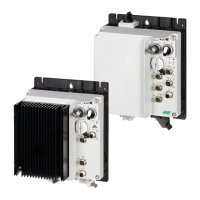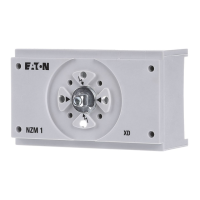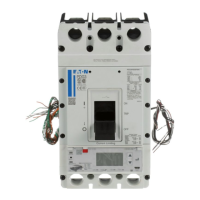6 RASP5 speed controller
6.4 Specific technical data
Rapid Link 5 · RAMO5 · RASP5 05/20 MN034004EN www.eaton.com 141
6.4.2 Derating curves
Although high switching frequencies allow for low running noise and faster
response times, they also produce higher losses at the power output stages,
as well as greater interference in the mains and motor cables. Because of
this, the
switching frequency should be set to the lowest possible value.
In Expert mode (P1-14 = 101), the switching frequency can be changed in
parameter P2-22.
The temperature of the RASP5 increases at higher switching frequencies.
The output current (I
2N
) should therefore be reduced (derating) according to
the ambient air temperature, when higher switching frequencies are used.
The following
derating curves show the output current in continuous opera-
tion as a function of
the
switching frequency (f
PWM
)
and
ambient tempera-
ture
.
Figure 85: f
PWM
= 8 - 32 kHz with RASP5-2…, RASP5-4…, RASP5-5…
Figure 86: f
PWM
= 4 - 32 kHz with RASP5-8…
→
If higher switching frequencies (>16 kHz) are required, the load
(output current) and/or the ambient temperature must be redu-
ced.
RASP5 - 5...
RASP5 - 4...
RASP5 - 2...
12 kHz
16 kHz
32 kHz
24 kHz
8 kHz
l
e
[A]
0
1
2
3
4
5
6
0 5 10 15 20 25 30 35 40 45 50 55
ϑ [°C]
0
10 20 30 40 50
l
e
[A]
RASP5 - 8...
0
1
2
3
4
5
6
7
8
9
4 kHz
12 kHz
16 kHz
32 kHz
24 kHz
8 kHz
50 55
ϑ [°C]

